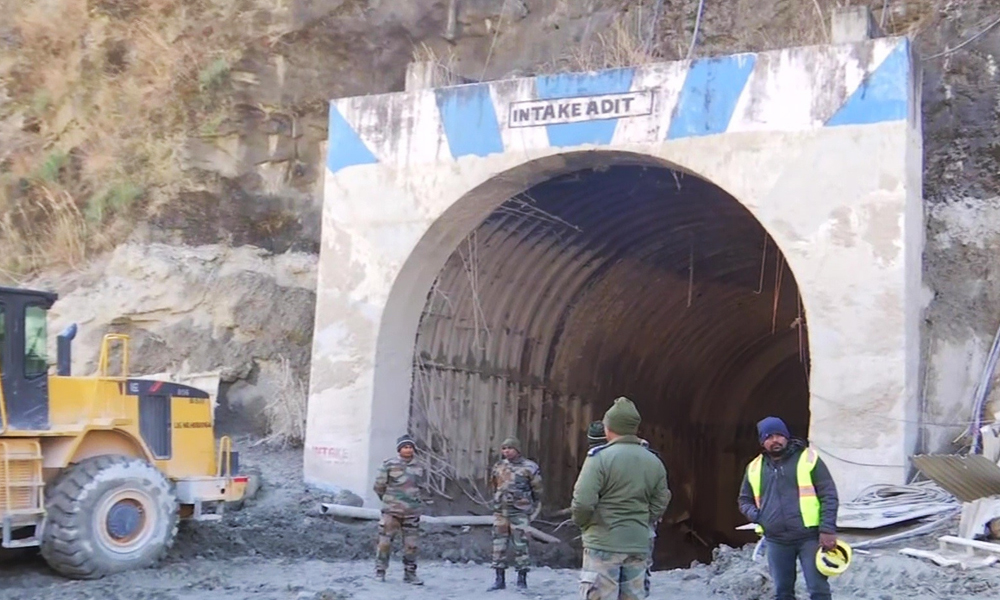
Image Credit: News18
Uttarakhand Disaster: National Green Tribunal Directs NTPC To Pay Rs 57.96 Lakh For Damaging Environment
Writer: Rakshitha R
Rakshitha an engineer turned passionate journalist with an inclination for poetry, creative writing, movies, fiction, mountains and seclusion. Not a part of the social process but existential.
Uttarakhand, 24 Feb 2021 11:18 AM GMT | Updated 24 Feb 2021 11:39 AM GMT
Editor : Shubhendu Deshmukh |
Shubhendu, the quint essential news junky, the man who loves science and politics in equal measure and offers the complete contrast to it by being a fan of urdu poetry as well.
Creatives : Abhishek M
" An engineer by profession, Abhishek is the creative producer of the team, graphic designing is his passion and travelling his get away. In more ways than one, he makes the content visually appealing."
A bench observed that the slope of the muck that was dumped at NTPC's Tapovan Vishnugad hydropower project in Chamoli district was hazardously double the standards with potential for erosion.
The National Green Tribunal (NGT) has scrapped the National Thermal Power Corporation (NTPC) Ltd's plea seeking the review of a Uttarakhand Pollution Control Board (PCB) order imposing a ₹57.96 lakh penalty for damaging the environment.
The state-owned power major had allegedly violated muck disposal site maintenance norms, which resulted in heavy damage to the environment.
A bench headed by the tribunal's Chairperson Adarsh Kumar Goel dismissed the NTPC Ltd's plea and observed that the slope of muck that was dumped at its Tapovan Vishnugad hydropower project in Chamoli district was hazardously double the standards. The bench also noted that such disposal had a potential for erosion.
"In view of the above, there is no merit in the appeal as "Polluter Pays" principle has been rightly invoked for damage to the environment. Accordingly, the plea was dismissed," the tribunal said, reported News18.
The bench observed that erosion was already seen in terms of gully formation in down streams of the muck dumps. "Thus, it is clear that the operative muck disposal sites were not being maintained as per the Ministry of Environment and Forests laid down norms," added the bench.
It further added that the penalty that the state pollution control board will collect from the power major, will be utilised for the restoration of the environment.
The NGT also noted that NTPC which is operating the Tapovan Vishnugad hydropower project has set up five muck disposal dumping sites out of which three reached full-capacity three to five years ago. At present only two are active and operational. Even in these two, the state pollution control board found deficiencies in two of the muck disposal dumping sites that were set up by NTPC at the project site.
The state PCB had passed the order under Section 33 A of the Water (Prevention and Control of Pollution) Act, 1974 (Water Act) requiring the NTPC to pay ₹57,96,000 as per the polluter pays principle for the restoration of the environment.
The 520 MW Tapovan-Vishnugad project was completely damaged on February 7 due to flash-floods after which 139 personnel associated with the project were reported missing.
The Tapovan Vishnugad Project
According to a report by the South Asia Network of Dams, Rivers and People, the Tapovan Vishnugad Hydropower project is the second project of NTPC, and a run-of-the-river project being built on River Dhauliganga at Chamoli district. The project was laid in 2005 whose construction began in 2006. The initial cost of the project is estimated to be ₹2978.48 crores.
The project demanded the conversion of about 144.59 hectares of land for permanent structures and ancillary sites. Of this, about 82.73 hectares of land was government-owned - classified as forest and revenue land. About 61.86 hectares was private land under cultivation by 630 owners in eight villages - Ravigram, Tapovan, Dhak, Paini, Selang, Paiya Chormi, Chamtoli and Bhengul.
The project also led to the resettlement of over 57 households. The major works for the project included the construction of the barrage, head rave tunnel (HRT), tailrace tunnels (TRT) powerhouse, and switchyard. The NTPC has given contracts to various companies for this.
Delays and damages
The project has been allegedly facing serious implementation issues from the start itself. Its cofferdam and barrage were repeatedly damaged even during the flash floods in 2011, 2012 and 2013.
The Tunnel Boring Machine (TBM) is stuck in the tunnel since December 2009 and has not been recovered until now. The project construction has damaged the river eco-system and local residents, according to the report.
The developer has also not been able to dispose of the tunnel muck safely, and its improper planning and negligence have led to financial losses, structural damages and delays in commissioning.
After hearing a plea from Gram Pradhan and residents of Tapovan against the muck mismanagement by the project developer, the NGT had directed the Uttarakhand Pollution Control Board to form an expert committee and submit a report in 2019.
Followed by this, the PCB formed a panel in January 2020 and visited the muck disposal sites in March. The report submitted by the tribunal has found many lapses in the safe disposal of the muck by the project proponent.
The muck on all the sites we found to be improperly dumped with the potential to run off to the river during rains. The protection walls at Dhak and TBM have also been damaged.
February 7th Disaster
The flash floods in the area after a glacier broke off on February 7, damaged both permanent structures and many of its ancillary facilities including the office.
The satellite images suggest that most of the barrage structure has been washed away. The long stretches of the remaining area up and downstream the barrage are found to be buried several feet under the sludge.
This has resulted in the ₹1500 crore loss to NTPC.
According to media reports, out of 204 missing people, over 139 were working in the Tapovan Vishnugad project and 53 in the Rishiganga project. Many workers were on weekly off due to Sunday otherwise the death toll could have been much higher.
The media reports also said that the NTPC officials were relying on communication from Rishiganga officials for flash floods. But the local alarm system at both project sites a phenomenon commonly observed in the case of hydro projects.
A senior NTPC official in this regard claimed they had taken a complete system of emergency measures but the water came with such volume and speed that reaction time was less.
A fortnight after the flash floods of February 7, the Uttarakhand government has declared the 136 people missing after the disaster as "presumed dead."
However, the hydropower project failed on all fronts and has turned into a financial burden as it has been repeatedly damaged by flash floods. The cost is expected to go up to five folds than initial estimates. Commissioning has been delayed for almost a decade.
Also Read: Motera Cricket Stadium, World's Largest, Renamed As Narendra Modi Stadium
 All section
All section














